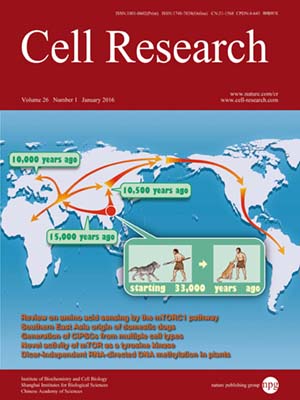
Volume 26, No 1, Jan 2016
ISSN: 1001-0602
EISSN: 1748-7838 2018
impact factor 17.848*
(Clarivate Analytics, 2019)
Volume 26 Issue 1, January 2016: 46-65
ORIGINAL ARTICLES
mTORC2 promotes type I insulin-like growth factor receptor and insulin receptor activation through the tyrosine kinase activity of mTOR
Yancun Yin1, Hui Hua2, Minjing Li3, Shu Liu1, Qingbin Kong1, Ting Shao1, Jiao Wang4, Yuanming Luo5, Qian Wang5, Ting Luo6 and Yangfu Jiang1
1State Key Laboratory of Biotherapy, Section of Oncogene, West China Hospital, Sichuan University, Chengdu, Sichuan 610041, China
2Laboratory of Stem Cell Biology, West China Hospital, Sichuan University, Chengdu, Sichuan 610041, China
3Medicine and Pharmacy Research Center, Binzhou Medical University, Yantai, Shandong 264003, China
4School of Basic Medicine, Chengdu University of Traditional Chinese Medicine, Chengdu, Sichuan 610075, China
5State Key Laboratory of Microbial Resources, Institute of Microbiology, Chinese Academy of Sciences, Beijing 100101, China
6Cancer Center, West China Hospital, Sichuan University, Chengdu, Sichuan 610041, China
Correspondence: Yangfu Jiang, Tel: 86-28-85164044; Fax: 86-28-85164046(jyangfu@scu.edu.cn)
Mammalian target of rapamycin (mTOR) is a core component of raptor-mTOR (mTORC1) and rictor-mTOR (mTORC2) complexes that control diverse cellular processes. Both mTORC1 and mTORC2 regulate several elements downstream of type I insulin-like growth factor receptor (IGF-IR) and insulin receptor (InsR). However, it is unknown whether and how mTOR regulates IGF-IR and InsR themselves. Here we show that mTOR possesses unexpected tyrosine kinase activity and activates IGF-IR/InsR. Rapamycin induces the tyrosine phosphorylation and activation of IGF-IR/InsR, which is largely dependent on rictor and mTOR. Moreover, mTORC2 promotes ligand-induced activation of IGF-IR/InsR. IGF- and insulin-induced IGF-IR/InsR phosphorylation is significantly compromised in rictor-null cells. Insulin receptor substrate (IRS) directly interacts with SIN1 thereby recruiting mTORC2 to IGF-IR/InsR and promoting rapamycin- or ligand-induced phosphorylation of IGF-IR/InsR. mTOR exhibits tyrosine kinase activity towards the general tyrosine kinase substrate poly(Glu-Tyr) and IGF-IR/InsR. Both recombinant mTOR and immunoprecipitated mTORC2 phosphorylate IGF-IR and InsR on Tyr1131/1136 and Tyr1146/1151, respectively. These effects are independent of the intrinsic kinase activity of IGF-IR/InsR, as determined by assays on kinase-dead IGF-IR/InsR mutants. While both rictor and mTOR immunoprecitates from rictor+/+ MCF-10A cells exhibit tyrosine kinase activity towards IGF-IR and InsR, mTOR immunoprecipitates from rictor−/− MCF-10A cells do not induce IGF-IR and InsR phosphorylation. Phosphorylation-deficient mutation of residue Tyr1131 in IGF-IR or Tyr1146 in InsR abrogates the activation of IGF-IR/InsR by mTOR. Finally, overexpression of rictor promotes IGF-induced cell proliferation. Our work identifies mTOR as a dual-specificity kinase and clarifies how mTORC2 promotes IGF-IR/InsR activation.
10.1038/cr.2015.133
FULL TEXT | PDF
Browse 3505


